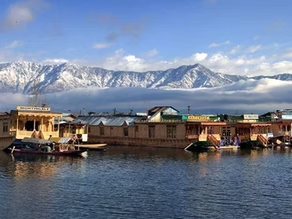Travel Guide Kashmir: The Heaven on Earth

When someone asks you if you would like to take a trip to Kashmir, what comes to your mind? Before considering the alternative, do you think twice? Do you recommend a destination elsewhere? Oh, shouldn’t you. I recently had a group trip that made me understand how scared most of us are of going to Jammu Kashmir on a trip and what a waste of a great chance it is! Kashmir tourism depends heavily on its visitors and thrives on individuals like us, you need to visit to see the stunning views and scenery provided by the area. The location has a variety to offer and the beauty of it all is the best aspect of the landscape or the scenery of the breath-taking Kashmir. The Scenic Beauty Srinagar, Kashmir is rightly crowned as “Heaven on the Earth” with its picturesque scenery and mesmerizing Dal Lake. Situated on the bank of the Jhelum River, Srinagar is the summer capital of the Jammu and Kashmir Union Territory. The center of Kashmir’s tourist attractions is the lively shikaras on Dal Lake. Green mountains create the ideal sound of romantic chill-outs, along with colorful Shikaras and houseboats. Srinagar draws thousands of tourists each year as the birthplace of several Mughal Gardens, exquisitely embroidered shawls, and floating vegetable markets. How to Reach: By air: The closest airport is Srinagar International Airport. As an international airport, it shares close relations with many foreign countries, including Mumbai, New Delhi, Kolkata, Chennai, Hyderabad, Bengaluru, and many more, as well as most of India’s major cities. By rail: In Srinagar, Kashmir, there is no railway. Srinagar’s closest railway destination is Jammu, which is about 290 kilometers away from Kashmir’s summer capital. Jammu railway station, being the region’s main railway, is well linked with the other parts of the country. Kashmir Valley in Autumn Regarding Visa: To travel to Earth’s paradise, foreigners require a visitor visa. Apply for an E-visa online along with the necessary documentation and fill in the form correctly. For residents of more than 150 countries, it is applicable. Before your stay, you will register for a minimum of 4 days and a maximum of 120 days. An Indian tourist visa is valid for 60 days and does not come with an extension period option. A standard tourist visa that is valid for 6 months is applicable if you are planning a long trip. Kashmir Valley in winter Best time to visit: You might have too many questions about this like the Best time to visit Kashmir, the Best time to visit Kashmir for snowfall, the Best time to visit Srinagar, the Best time to visit Gulmarg, the Best time to visit Gulmarg for snowfall, and a lot more : Srinagar is a popular tourist destination due to the friendly climate and relaxing weather during the year. While people from all over the world visit Srinagar during the year, the best time to visit Srinagar Kashmir is considered to be from April to October. When you pay a visit during this season, along with other things, you will enjoy nature to the fullest. Summer and winter are two of this valley’s major seasons. Summer temperatures vary from around 14 to 30 degrees Celsius, while winter temperatures range from -4 to 15 degrees Celsius. Not much rainfall is witnessed in Srinagar because of its location. Over the summer, cool and nice weather helps to admire the majestic beauty of the Kashmir valley. Visiting makes the sightseeing hassle-free during summer. In addition to visiting other spectacular sites, the Tulip Festival held in summer is the center of attractions. Things to See in and around Srinagar Shikara ride in Kashmir A sunset shikara ride on Dal Lake: On Dal Lake, a shikara trip is a no-brainer. Visitors to Kashmir are greeted by Kitschy vessels, littered in bright carpets and rugs. In the evening, we recommend going for a ride so that you can continue when the sky is still blue and spot reflections of the surrounding mountains and plans in the water, and hang around until the sunsets. With my wife, we visited Srinagar and this was one of her favorite activities in Srinagar to do. Dal Lake: The first alternative for tourists in Srinagar is Dal Lake. An excellent scene is formed by the colorful wooden boats or Shikara floating on the lovely water of Srinagar Dal Lake. An intimate chill out in the houseboat is an unforgettable experience that you want to experience on your journey. In terms, the seductive essence of the surroundings and the sunset and sunrise from Dal Lake is indescribable. Shikaras of Dal Lake Floating Market in India Floating Market on Dal Lake: Then visit the floating vegetable and flower market at Dal Lake at sunrise if you don’t mind setting up your alarm for an unearthly hour. This busy marketplace is genuinely special because boat shops are set up by manufacturers and buyers often come by boat. As this is one of the tourists’ most famous experiences, for this experience, expect to shell out around INR 2000-2500 (£25-30). Shalimar Bagh Mughal Garden Shalimar Bagh: During the Mughal Period, Shalimar Bagh was also installed. In order to impress Noor Jahan, Jahangir designed this Persian style of architecture. This garden, situated beside Dal Lake, is surrounded by trees and has a canal in the center as well. You will appreciate various facets of the beauty of the garden from the three terraces of Shalimar Bagh. Indira Gandhi Tulip Garden in Srinagar Indira Gandhi Tulip Garden: A must-visit tourist spot in Srinagar is the Tulip Garden, named after the former Prime Minister of India. In this garden, you can discover almost 60 varieties of tulips. This garden is considered the largest tulip garden in Asia, occupying almost 12 hectares of land. A host of bright tulips covering a vast land leaves your mind with a lasting impression. Pari Mahal Kashmir
North Sikkim- A Slice of Heaven | TTW

Sikkim is a small state in northeast India, bordered by Bhutan, Tibet, and Nepal. Part of the Himalayas, the area has a dramatic landscape including India’s highest mountain, 8,586m Kanchenjunga. Sikkim is also home to glaciers, alpine meadows, and thousands of varieties of wildflowers. High snow-capped mountains, flowing rivers, chilled wind, wildflowers, colorful wildlife, and beautiful people made the Himalayan state Sikkim most beautiful. The northern part of Sikkim is a very popular travel destination among tourists and is certainly the best part of Sikkim. This barren land is popular for its breathtaking views. Though many people called it ‘Small Ladakh’ but this place is beautiful to its virginity. The main attraction of North Sikkim is based on Gurudongmar Lake (the holy lake), Zero Point (the snow zone), Yumthang Valley(the valley of flowers), Lachung, and Lachen. Generally, this place is appropriate for a 2night/3 days trip but you may add more days depending on the places you would like to visit and also depends on what type of traveler you are. How to reach Sikkim: By Air: The regularly operated airport nearest to Gangtok is about 124 Kms away in Bagdogra, West Bengal. From the airport, you can hire a shared taxi or a private vehicle that will get you to Gangtok in around 3-4 hours. The Pakyong Airport is the only airport serving Sikkim which is just 27 km away from Gangtok but it’s not regularly operated. By Train: The nearest railway station to Gangtok is New Jalpaiguri(NJP), around 148 km away from Gangtok. From NJP you can easily get a taxi to Gangtok. It will take around 4-4.5 hrs to reach Gangtok. By Road: Tourists coming from nearby places like Siliguri, Darjeeling, Kalimpong, or any nearby place can even drive to Gangtok. Sikkim is well connected with West Bengal and the other nearby places. Know more about how to visit Sikkim here. Best Itinerary for Sikkim Trip: I would suggest a minimum of one week, but if you have more days, it’s better and you can even explore more. Day 1: Reach Gangtok by Road, Train, or Air. Day 2: Explore Gangtok and surroundings (city tour). Day 3: Explore Tsongmo Lake and return to Gangtok. Days 4-6: North Sikkim Tour: Visit Yumthang Valley and Gurudongmar Lake via Lachen & Lachung. Day 6: Road Trip and transfer back to Gangtok Day 7: Transfer to Bagdogra Airport/ NJP/ or travel back home by Road. Here’s the best time to visit Sikkim. It’s like a base itinerary that you can follow, but you can of course end up doing something quite different, often changing plans while traveling as you learn about new places and gather new experiences. Day 1(Reach Gangtok and relax): You can hire a cab for Gangtok. During the journey, ask your cab driver a lot of questions about the long journey from the airport/train station/bus stop, try to accumulate as much information as you can. The road is quite good, and you’ll enjoy the journey. However, on the way, do stop by and admire the mighty Teesta river – it’s truly a sight to behold. By the time you reach Gangtok, you will be exhausted and would just want to take some rest. So take enough rest and hydrate yourself. If you have energy in the evening, head out to the MG Marg – that’s where everyone from the city gathers to hang out and is the most vibrant place you will ever see. Enjoy your time over there. Day 2(Visit the Gangtok city): You can spend your time hopping around the local shops, eating the local foods, sightseeing and organizing onwards travel. Many of the places to visit in Gangtok can be seen on ubiquitous “three-point”, “five-point”, and “seven-point” local tours offered by travel agents, hotels, and taxi drivers. The “three-point” tours incorporate the city’s three main viewpoints (Ganesh Tok, Hanuman Tok, and Tashi Viewpoint). Variants such as the Enchey monastery can be added for “five-point” tours. “Seven points” tours include monasteries outside Gangtok, such as Rumtek and Lindum. Enchey Monastery: Sikkim’s monasteries are among its most popular attractions. You’ll find Enchey monastery perched on a ridge above Gangtok. The name of this serene place means a solitary monastery. It was initially constructed in 1909 but had to be rebuilt after catching fire in 1947. This monastery is relatively small and noncommercial. However, it’s beautifully decorated inside, with colorful murals, statues, and a large collection of masks used in ritual dances. The founder, Lama Druptob Karpo, was a Tantric master known for his ability to levitate and fly! Enchey monastery is open from 4 a.m. until 4 p.m. Monday to Saturday, and until 1 p.m. on Sunday. Two renowned monasteries can also be seen on scenic day trips from Gangtok: Rumtek, and the newer and more eye-catching Lingdum (Ranka) with its huge golden Buddha statue. Be at Lingdum at 7.30 a.m. or 3.30 p.m. to hear the monks chanting in mesmerizing unison. Ganesh Tok and Hanuman Tok: From Enchey monastery, take the road northeast up to colorful Ganesh Tok with its fluttering prayer flags, for dramatic views over Gangkok. There’s a temple dedicated to Lord Ganesh there, along with cafe and souvenir shops. Higher up beyond Ganesh Tok, and arguably with a better viewpoint, sits Hanuman Tok. Visitors are greeted by a towering orange statue of Lord Hanuman. The Hanuman temple there is maintained by the Indian Army, so it’s clean and peaceful. It’s surrounded by lovely sprawling gardens, walking trails, and the splendid sight of Mount Khangchendzonga on a clear day. Himalayan Zoological Park: Opposite Ganesh Tok, the Himalayan Zoological Park is one of India’s better-maintained zoos with a natural jungle setting. It’s spread across 230 hectares of hillside and houses rare animals, many of which have been rescued from traders and poachers. They include Himalayan bears, snow leopards, Tibetan wolves, and red pandas. The

